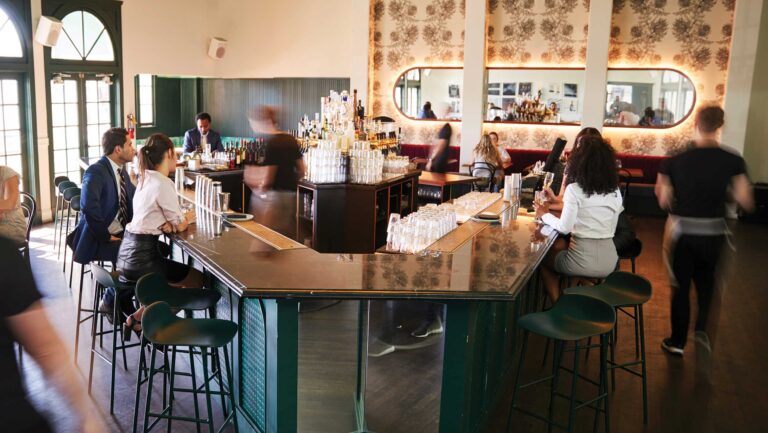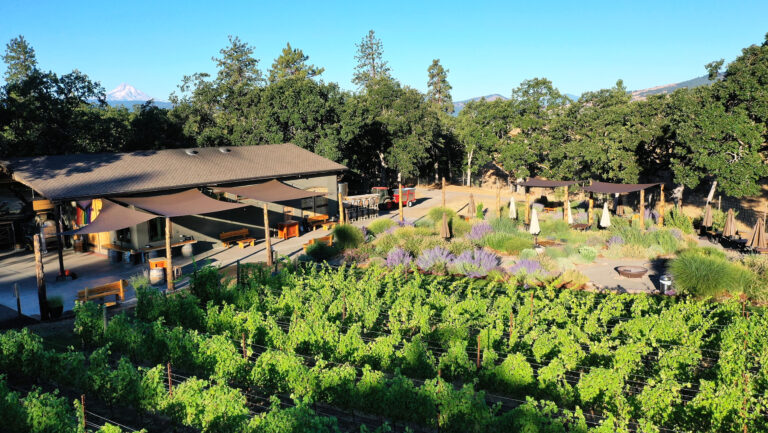I didn’t walk into this job—I grew into it. I started out as a server at our flagship restaurant, Rustic Canyon, in Santa Monica, California, in 2006. In 2010, I took over the wine program there. I opened Milo & Olive in 2011 and Cassia in 2015. While training for the Los Angeles Marathon with my friend Josh Loeb, Rustic Canyon’s CEO, I got to talking with him about the idea of starting a wine bar and shop. We wrote up a business plan and then partnered to open Esters, also in 2015. Simultaneously, I became the wine director for the entire Rustic Canyon group—and I had a baby. Then I opened Tallula’s this past spring. It’s been a busy two years.
In a way, my role is a lot like that of a creative director. Not only do I oversee the selections, but I also decide how the menu is going to look pricewise, what the spread is going to be, and how the wine lists will be presented from restaurant to restaurant. I also act as a mentor to our managers and somms, conducting staff trainings and helping to build a crew of passionate, inspired, and educated wine lovers to sell the wines on our lists.
Each restaurant in Rustic Canyon’s group is distinct. They all have the same CEO but different partners and chefs. I manage all of the wine programs, and with the exception of Rustic Canyon, I also conceptualized each one from preopening. Rustic Canyon has always had a very strong domestic list, with a particular focus on Pinot Noir (that’s Josh’s love). It also has an emphasis on selections from Italy (our sommelier is from Naples) and Burgundy, and a little bit of everything else. Milo & Olive has a list that’s accessible, with a number of less expensive options—wines that go with pizza and comfort food. Cassia’s list is eclectic and fun—it’s all about complementing Bryant Ng’s southeast Asian cuisine. Tallula’s has a super-small list of 30 wines from around the world that pair well with Mexican food. And Esters is a wine bar, so it’s the only place where wine comes first and then food to match. There we have lots of imports, especially Italian and French wines, including long lists of Champagnes and Burgundies.

Don’t miss the latest drinks industry news and insights. Sign up for our award-winning newsletters and get insider intel, resources, and trends delivered to your inbox every week.
Like many wine directors, I’m expected to run certain percentages. The executive team gives me my target at the beginning of the year, so I know where we need to get to. But the role each restaurant plays in the percentages is different, depending on whether it has a liquor program or beer program, or not. I don’t have a specific set formula for hitting my numbers, but I like to have a lot of say in pricing. The way I price the wines we’re pouring—and where they are in relation to other things on the list—allows me to be creative in how I reach my percentage goals.
Overseeing multiple programs is a big job, but here are 10 surefire ways to get it right.
1. Think beyond your own palate.
The best thing you can do is to use your palate to identify the wines that’ll be a perfect match for each restaurant’s chef, food, and vibe. Of course, when you’re dealing with multiple programs, there’s a through line that’s connecting them. My general philosophy is to serve great wine from small boutique producers and, whenever possible, from family-owned estates that practice organic, natural, or sustainable winemaking.
2. Build a concept that’s versatile.
Menus change seasonally, monthly, and even daily in our group, which makes understanding each chef’s cooking style and flavors critical. It helps you find wines that work with a variety of menu items. As a result, we always have Champagne at Esters, some wines with residual sugar at Cassia, and comfort wines at Milo & Olive.
3. Hire a great team.
If you’re running multiple spots, you can’t do it alone. You need help—a lot of it. Logistically, you need staff to order and receive deliveries, put new products into the computer system, stock, track inventory, and sell wine on the floor. This can be split among managers and leads, but it works best when you have one really dialed-in wine person at each location. Our Rustic Canyon somm, Ferdinando Mucerino, and Cassia somm, Marisa Brown, are indispensable. Take the time to hire and train the right people. (The top two qualities I look for are organization and passion.) The more you delegate to people you trust, the better you’ll be able to manage things from the top. I love my team.
4. Teach, teach, teach.
Talk to managers, sommeliers, servers, and those in the back of house. Do wine education for everyone so they all understand and can articulate the focus of the program to any guest at any time. Then include them in tastings and do focused trainings weekly and monthly.
5. Taste with stakeholders.
I set up appointments every Monday with distributors and invite the sommeliers, managers, and leads from each restaurant to join. Tasting together is incredibly valuable because it helps you all understand each other’s palates and programs. There’s nothing competitive about it—we’re just trying to figure out what fits best where and how we’re responding to the wines. The only dilemma is when every stakeholder wants the same thing (Hello, Alfredo Maestro El Rey del Glam 2016 Grenache).
6. Know your BTG personalities.
Have a short, succinct philosophy for each location, particularly by the glass (BTG). Strike a balance between what pairs with the food, what price range makes sense, and the focus of the restaurant. For example, Milo & Olive serves pizza and comfort food, so the price range for the BTG program is a bit lower ($10–$17) than the one at Esters. At Esters we can experiment more with varieties and regions, and we have a broader range of BTG prices. (Right now we have Chapelle St. Theodoric Châteauneuf-du-Pape Les Sablons 2014 at $28 a glass.)
7. Divide up allocations.
One of the huge perks of overseeing multiple programs is the opportunity to work with more allocations. We can do more business than a stand-alone restaurant, so we often get offered more allocations. And because we can split them among multiple restaurants and spread out the budget, I usually take the whole allocation.
8. Take advantage of buying power.
Because I buy for multiple locations, I can buy enough quantity to always get the best pricing. I’m not a hard-ass; we just do good business. Don’t settle for anything less.
9. Visit your restaurants as a customer.
The most important thing about being a wine director for a group is thinking about the big picture and seeing the restaurants from an outside perspective. I try to dine and experience each spot a few times a month. I look at the wine list, order new dishes, talk to the servers, and feel the place. It helps me get in touch with what’s going well—and where the holes are (if there are any).
10. Keep your car trunk empty (or a hand truck handy).
At some point you will end up transporting wine from one location to another. There will be a last-minute tasting, a special pairing dinner, or an allocation that needs dividing, and you will end up being the person who takes the wine to the other location. Lucky for me all of our spots are in Santa Monica—I have been known to transport cases of wine in my baby’s stroller.
—As told to Jen Laskey

Dispatch
Sign up for our award-winning newsletter
Don’t miss the latest drinks industry news and insights—delivered to your inbox every week.
Kathryn Coker is the wine director for the Rustic Canyon family of restaurants in Santa Monica, California, and one of Food & Wine magazine’s 2017 Sommeliers of the Year. She is also a partner in Esters Wine Shop & Bar.







